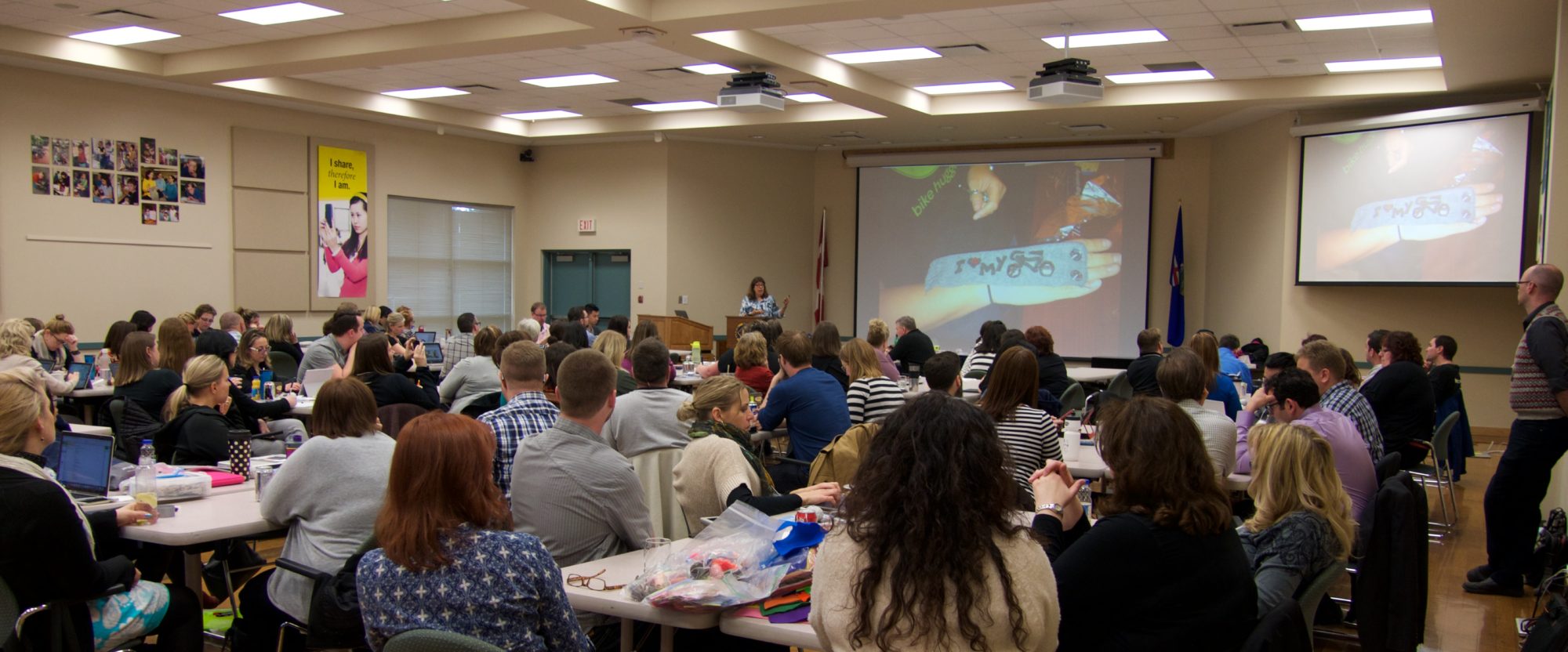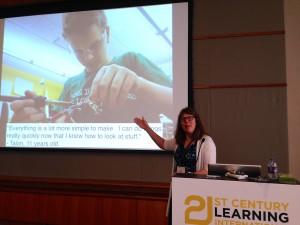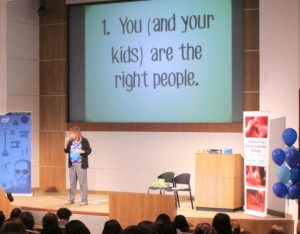[A version of this post appeared on the website: Engaging Modern Learners in a compilation of articles on self-directed learning.]
In my recent book, Invent To Learn: Making, Tinkering and Engineering the Classroom, there are many stories shared by teachers about how to create opportunities that support self-directed learning in their classrooms using modern technology. This one is from Maryann Molishus, a teacher in Pennsylvania who has taught both second and fifth grade.
“What do you want to learn and how do you want to share it with the class?” This is how I began second grade for many years. The ideas would start off ordinary. “I want to learn about tigers, and I will write a book about them.” Then, there would continue to be requests to make a variety of animal books. Eventually there would be a child who seemed to want to challenge me – did I really mean ANYTHING? “I want to be a book critic and make my own television show,” or “I want to be a scientist, mix things up, and see what happens,” or “I want to make a video game.” There would be a collective gasp. Surely that’s not what I meant. But, I’d casually write down the requests, give a nod, and continue on with more requests until the animal book authors would begin asking to change their ideas to less traditional projects. It happened every year. And knowing that students, both in second and in fifth grade, are surprised by what they can do means that each year my goal is always to make what seems to them to be the extraordinary the norm for my classroom.”
This may seem like a simple brainstorming process, but in fact, this is a carefully planned scaffolding technique for encouraging self-directed learning. The teacher’s role is to help students move past what they know school usually asks of them and take a chance on something that they really want to do. Her seemingly “casual” acceptance of any idea is powerful pedagogy. It makes it less risky for students, all kinds of students, to come up with ideas that are more personal. It is a way to start children on a path towards owning their own learning and challenging themselves to do the extraordinary.
The decision to make self-directed learning a priority in a learning organization means asking a lot of hard questions.
- What does “self-directed learning” mean?
- Is this something that will be infused into all classes and subjects?
- Is it just for some kids? If so, which kids?
- If the students are learning by themselves, what do teachers do?
- What is it about the organization that currently supports self-directed learning and how can we build on those strengths?
- On the other hand, what existing practices and processes discourage or even prevent self-directed learning?
As you ask and answer these questions, one issue that should shape your approach to self-directed learning is gender. Gender identity studies often show that girls have different problem-solving approaches than boys. This does not mean that all girls or all boys solve problems in a single style, but that there is a wide range of approaches.
For example, teachers need to understand their crucial role in self-directed learning is that of a helpful, but not judgmental mentor and guide. Girls tend to be “people pleasers” more than boys, and their relationships with teachers are very important to them. This may mean that they will avoid a path not suggested or anticipated by the teacher. Teachers need to remember that their suggestions carry a great amount of weight. To counter this and encourage self-directed learning, teachers need to train themselves to offer neutral, yet encouraging support for students to think outside the box. This conflicts with the traditional role of teacher as both the giver and the ultimate judge of student work, and should bring both assignment and assessment practices into question.
It may be more difficult for girls to express what they want to do in choosing a project or a topic for self-directed study. Typically, the teacher will jump in with suggestions or options, and students have been trained to just wait for that to happen,. Teachers need to let students struggle productively for longer than they may be used to. This change in strategy will take time to develop trust that the teacher really means that they aren’t going to tell students what to do, but also will not tolerate “goofing off”.
Girls tend to use more collaborative techniques such as building consensus and adapting rules than boys do. Boys more often approach a problem as a personal challenge and work on it to the point of obsession. In tackling self-directed learning, all these characteristics are helpful, yet taken to the extreme, will sabotage the learner. Building consensus through collaboration is a good skill to master, but not being able to make a decision or get anything done is a bad habit. Tackling a problem with enthusiasm is a good thing, but allowing unbounded competition or grinding an unproductive idea to death is a bad outcome. Teachers are the key to making sure that these tendencies are expressed and channeled in ways that support learning for all without squashing motivation.
Girls will not fight for scarce resources. Be mindful of that to ensure that the opportunities for self-directed learning are open to everyone, not just a select few who are aggressive, vocal, or get there first. Tools and technology should be plentiful and easy to access. If there are not enough computers or materials, or if the access to them is made difficult, you may see gender-specific reactions to your program.
Girls tend to be more tolerant of a wide variety of situations – meaning that they “get along” better in traditional school settings. So you may assume that girls don’t need self-directed learning because they have mastered coping in the traditional classroom. While there may be more boys who do not thrive in traditional classrooms, this is not an indication that girls don’t need options as well.
There are some gender-related tendencies that suggest that girls will handle some of the requirements of self-directed learning better than boys.
Some people assume that self-directed learning means solitary learning. This is far from the truth. Mardziah Hayati Abdullah of the US Department of Education writes that self-directed learning is both collaborative and social, where the learner collaborates with both teachers and peers. Students must learn how to navigate new ways of getting and sharing information with others, both in real life and online. Creating opportunities for self-directed learning means more collaboration and communication, not less, an area in which girls excel.
Girls are generally more organized and better able to self-monitor, another requirement for self-directed learning. However, providing good documentation and turning things in on time should not be confused with doing good work. Girls may be better with project planning tools, collaboration networks, and other technology tools that support these areas.
You may find the opposite is true for technology used in the actual design and development of student projects. Some boys may master software apps, programming, robotics, and other technology with ease, where girls hold back. Conventional wisdom and culture say that boys are just “better at technology” than girls, which reinforces this. However, this is a difference of style, not skill or potential. Many boys are content with mastering technology for its own sake, where girls want a reason to do so, such as designing a product that helps others or solves a problem. Offering both these kinds of opportunities to learn about using technology is crucial for a gender-balanced approach to self-directed learning.
One way to support both genders in learning to use technology is to deliberately recruit a wide range of students as peer mentors and leaders. This should not only be a mix of genders, but also of academically successful students with students who are not getting all As.
Training students to mentor their peers to use technology has multiple benefits. Placing students in positions of leadership and authority models student-led, student-centered learning where the teacher is not the guru who has all the answers. This is not just for show – creating student expertise in useful technology tools frees the teachers and other staff to do their jobs, not be tech support.
Understanding gender differences can inform your choices about self-directed learning initiatives in your organization and help educators create a balanced approach that supports all students.



 FabLearn 2014 is the third annual conference on making, fablabs, and education. This is a high quality event for educators, researchers, and designers to meet and talk about things that matter in the quest to make schools more authentic places for kids to learn.
FabLearn 2014 is the third annual conference on making, fablabs, and education. This is a high quality event for educators, researchers, and designers to meet and talk about things that matter in the quest to make schools more authentic places for kids to learn. The
The 